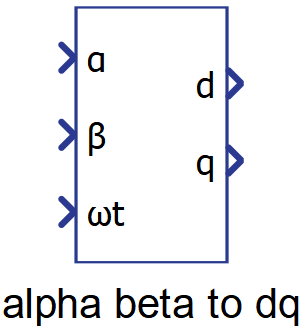αβ to DQ
Description of the αβ to DQ component in Schematic Editor, which performs an αβ to DQ transformation.

Description
This component performs the αβ to dq transformation, also known as Park's transformation. This transformation rotates the two stationaries axes αβ synchronously with a reference frequency. The reference frequency is passed through the phase input ωt. The rotating frame alignment has two modes:
- 0 - The rotating frame is aligned with the α axis. When the αβ signals come from a balanced three-phase signal with unitary positive-sequence magnitude the outputs of this mode are d = 0 and q = -1.
- -pi/2 - The rotating frame alignment is behind the α axis in 90°. When the αβ signals come from a balanced three-phase signal with unitary positive-sequence magnitude the outputs of this mode are d = 1 and q = 0. This is the default option used in Typhoon's components.
Alpha-beta to dq 0 alignment transformation matrix:
Alpha-beta to dq -pi/2 alignment transformation matrix:
The matrix computation is implemented with and optimized code by computing the sine and cossine only once as follows:
Where for 0 alignment and ;
and for -pi/2 alignment and .
Ports
- α (in)
- Input signal of the component related to the alpha signal of the
alpha-beta sequence frame.
- Supported types: real, int, uint.
- Vector support: no.
- Input signal of the component related to the alpha signal of the
alpha-beta sequence frame.
- β (in)
- Input signal of the component related to the beta signal of the
alpha-beta sequence frame.
- Supported types: real, int, uint.
- Vector support: no.
- Input signal of the component related to the beta signal of the
alpha-beta sequence frame.
- ωt (in)
- Angular position of the dq rotating frame.
- Supported types: real, int, uint.
- Vector support: no.
- Angular position of the dq rotating frame.
- d (out)
- Output signal of the component related to the direct component of the αβ
input.
- Supported types: real.
- Vector support: no.
- Output signal of the component related to the direct component of the αβ
input.
- q (out)
- Output signal of the component related to the quadrature component of the αβ input.
- Supported types: real.
- Vector support: no.
Properties
- Rotating frame alignment
- Defines the alignment of the dq signals (-π/2 = “q”, 0 = “d”).
- Execution rate
- Type in the desired signal processing execution rate. This value must be compatible with other signal processing components of the same circuit: the value must be a multiple of the fastest execution rate in the circuit. There can be up to four different execution rates. To specify the execution rate, you can use either decimal (e.g. 0.001) or exponential values (e.g. 1e-3) in seconds. Alternatively, you can type in ‘inherit’ in which case the component will be assigned execution rate based on the execution rate of the components it is receiving input from.